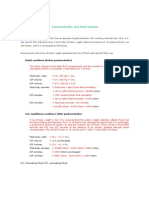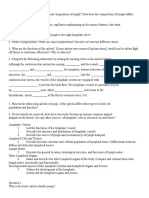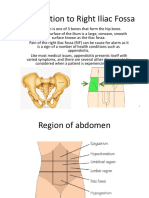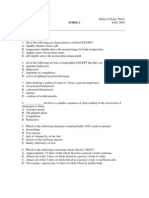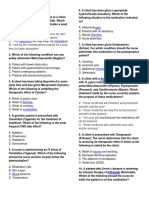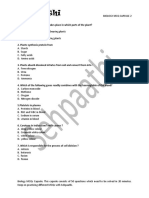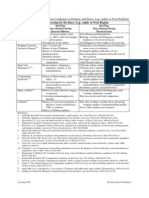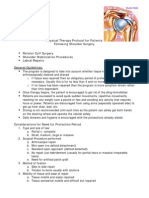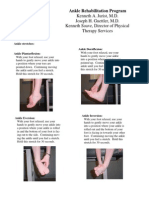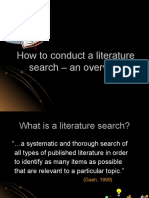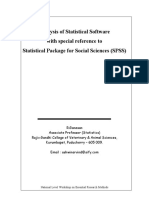0 ratings0% found this document useful (0 votes)
358 viewsCardio
Cardio
Uploaded by
ShrutiThe tricuspid and mitral valves differ from the semilunar valves in that the latter a. Are subjected to more stress and pressure. The clinical signs and symptoms of severe heart failure include all of the following except a. Hypertrophy. B. Resultant congestive heart fai lure.
Copyright:
Attribution Non-Commercial (BY-NC)
Available Formats
Download as PDF, TXT or read online from Scribd
Cardio
Cardio
Uploaded by
Shruti0 ratings0% found this document useful (0 votes)
358 views6 pagesThe tricuspid and mitral valves differ from the semilunar valves in that the latter a. Are subjected to more stress and pressure. The clinical signs and symptoms of severe heart failure include all of the following except a. Hypertrophy. B. Resultant congestive heart fai lure.
Copyright
© Attribution Non-Commercial (BY-NC)
Available Formats
PDF, TXT or read online from Scribd
Share this document
Did you find this document useful?
Is this content inappropriate?
The tricuspid and mitral valves differ from the semilunar valves in that the latter a. Are subjected to more stress and pressure. The clinical signs and symptoms of severe heart failure include all of the following except a. Hypertrophy. B. Resultant congestive heart fai lure.
Copyright:
Attribution Non-Commercial (BY-NC)
Available Formats
Download as PDF, TXT or read online from Scribd
Download as pdf or txt
0 ratings0% found this document useful (0 votes)
358 views6 pagesCardio
Cardio
Uploaded by
ShrutiThe tricuspid and mitral valves differ from the semilunar valves in that the latter a. Are subjected to more stress and pressure. The clinical signs and symptoms of severe heart failure include all of the following except a. Hypertrophy. B. Resultant congestive heart fai lure.
Copyright:
Attribution Non-Commercial (BY-NC)
Available Formats
Download as PDF, TXT or read online from Scribd
Download as pdf or txt
You are on page 1of 6
CHAPTER 11, CARDIOVASCULAR PHYSICAL THERAPY 793
Comprehension Questions
NOs
= The term “cardiac output” refers to the amount of blood pumped by the heart
A. During any 24-hour period.
B. Relative to body mass.
C. Relative to respiratory rate.
D. During 1 minute.
. What is the function of the pulmonary arteries?
. Which component of blood is the primary transporter of oxygen in mammals and
many other species?
. In the heart, what is the function of the AV node?
. On which side of the heart is the tricuspid valve?
. From which arteries does the heart receive its own blood supply?
. Which of the four chambers of the heart receives blood from the systemic circulation
via the superior vena cavae?
. What causes the first heart sound (lubb)?
|. The tricuspid and mitral valves differ from the semilunar valves in that the latter
A. Are subjected to more stress and pressure.
B. Are located within the heart.
C. Do not have attachments to papillary muscles.
D. Have attachments to papillary muscles.
The state of the cardiac chamber during its period of contraction is known as
A. Syncope.
B. Diastole.
C. Systole.
D. None of the above.
- True or false: Starling’s law states that within physiologic limits, stretching of the heart
muscle will increase the vigor of contractions.
A. True.
B. False.
. The clinical signs and symptoms of severe heart failure include all of the following
except
‘A. Hypertrophy.
B. Resultant congestive heart failure.
C. Lower than normal cardiac output.
D. Higher than normal cardiac output.
794
SECTION ll, TESTS AND MEASURES
13.
20
21.
True or false: For any given cardiac output, the mean pressure will be controlled by
the resistance factor.
A. True.
B. False.
The heart sounds heard by using a stethoscope over the anterior surface of the chest
are associated primarily with
‘A. A combination of the respiratory intake plus the heartbeat.
B. The contraction of the ventricles.
C. The contractions of the atria.
D. The opening and closing of the four major heart valves.
. What is the function of the chordae tendineae?
}. True or false: Cardiac tissue has the ability to depolarize spontaneously—to contract
without external nervous stimulation.
A. True.
B. False.
. Which of the following is the normal conduction pathway for muscular contraction
of the heart to follow?
A. Left ventricle, right ventricle, atrium.
B. Right atrium, left atrium, ventricles.
C. Left atrium, right atrium, ventricles.
D. Right ventricle, left ventricle, atrium.
All ofthe following are involved with peripheral circulation except
A. Arteries.
B. Capillaries.
C. Veins.
D. Sinuses.
). At what part of the cardiac cycle do the coronary arteries receive the majority of their
blood flow?
Al ofthe following are signs and symptoms associated with atherosclerosis except:
A. Increase in systolic pressure.
B. Little or no increase in diastolic pressure.
C. Large increase in pulse pressure.
D. No appreciable change in mean pressure.
The specialized receptors lying in the carotid sinus and the aortic arch involve all of
the following except
A. Mechanoreceptors.
B. Pressoreceptors.
C. Baroreceptors.
D. Chemoreceptors.
Active forces that contribute to lymphatic flow include all ofthe following except
A. Skeletal muscle function.
B. Negative intrathoracic pressure.
C. Lymphatic valves.
D. Cardiac function.
23.
24,
26.
2
28.
29.
30.
CHAPTER 11, CARDIOVASCULAR PHYSICALTHERAPY 795,
What effect does the Bainbridge reflex have?
Factors promoting venous return to the heart during exercise include all of the
following except:
A. Comparative ease of flow from arteries to veins through dilated skeletal muscle
arterioles.
B. Increase in venous tone,
C. Increased respiratory movements.
D. Decreased peristalsis
. Edema may be defined as all ofthe following except
A. Brawny or indurated.
B. Excess fluid in the interstitial space.
C. Acquired or congenital
D. Excess fluid in the intercellular space.
Clinical signs and symptoms of congestive heart failure include
A. Orthopnea
B. Cyanosis
C. Pitting edema.
D. All of the above.
Hypertrophy ofthe left ventricle ofthe heart is associated with
A. Aortic stenosis.
B. Mitral stenosis.
C. Pulmonary stenosis.
D. None of the above.
The clinical features of right ventricular hypertrophy in congestive heart failure do
not include which of the following?
A. Cyanosis.
B. Dyspnea
C. Edema of the lower extremities.
D. Ascites.
Which of the following cardiovascular disorders causes hypertrophy of the left
ventricle?
A. Pulmonary hypertension.
B. Systemic hypotension.
C. Stenosis of the mitral valves.
D. Stenosis of the aortic valves,
Which of the following clinical features of congestive heart failure would not be
attributable to right ventricular failure?
A. Pulmonary edema.
B. Increase in venous pressure.
C. Peripheral edema.
D. Congestion of the liver
796 SECTION TESTS AND MEASURES
31. The most frequent area of involvement for myocardial infarction is in the
A. Right ventricle.
B. Right atrium.
C. Left ventricle.
D. Left atrium.
32. A disease involving the aorta and its large branches is called
A. Arteriosclerosis.
B. Atherosclerosis.
C. Arteriolosclerosis.
D. Venosclerosis.
33. The P-wave of an ECG corresponds to which ofthe following?
A. Mitral depolarization.
B. Atrial depolar
C. Mitral repolarization.
D. Atrial repolarization.
34. The T-wave of an ECG is generated by
A. Atrial repolarization.
B. Atrial depolarization.
C. Ventricular repolarization.
D. Ventricular depolarization.
35, Intermittent claudication in the lower extremities suggests
A. Still's disease.
B. Raynaud! disease.
C. Buerger’s disease.
D. Pott’s disease.
36. Acute bacterial endocarditis may develop from
A. Gonococci.
B. Pneumococci.
C. Streptococci.
D. All of the above.
37. The closure of the mitral valve occurs when
A. Left atrial pressure equals left ventricular pressure.
B. Left ventricular pressure exceeds let atrial pressure.
C. Left atrial pressure exceeds aortic pressure.
D. Left atrial pressure exceeds left ventricle pressure.
38. One of the early symptoms of mitral stenosis is
A. Palpitations.
B. Angina.
C. Chest pain.
D. Dyspnea with exertion,
CHAPTER 11. CARDIOVASCULAR PHYSICALTHERAPY 797,
39. The physiologic actions of epinephrine includ
A. Decreased blood pressure.
B. Peripheral vasodilation.
C. Increased heart rate.
D. Vasoconstriction of cardiac muscle blood vessels.
40. What is the normal resting blood pressure for adults?
41. Describe the classic triad for the pathogenesis of venous thrombosis.
42. Where do most deep vein thromboses (DVT) originate?
43. When do most postoperative DVTs occur?
44. Whaat is the most serious complication of DVT?
45, What prophylactic measures are recommended to prevent DVT?
46. What are the signs and symptoms of pulmonary thromboembolism?
Answers
1. The answer is D.
2. To carry oxygen-deficient blood that has just returned from the body to the lungs,
where carbon dioxide is exchanged for oxygen.
3. Hemoglobin.
4. To delay the impulse from the SA node.
5. The right side.
6. The right and left coronary arteries.
7. Right atrium,
8. The AV valves closing.
9. The answer is C.
10, The answer is C.
11. The answer is A. This statement is true.
12. The answer is D.
13, The answer is A. This statement is true.
14. The answer is D.
15. To prevent the valves from everting when the ventricles contract, thereby stopping
any backflow of blood.
16. The answer is A. This statement is true.
17. The answer is B.
The answer is D.
798
SECTION Il TESTS AND MEASURES
19.
20.
21.
22.
23.
24,
25.
26.
27,
28.
29.
30.
31.
32.
33.
34,
35.
36.
37.
38.
39.
40.
41.
42.
43.
44,
45.
46.
During diastole.
The answer is D.
The answer is D.
The answer is D.
The reflex decreases the sympathetic input and heart rate on those occasions when
the heart is beating too rapidly.
The answer is D.
The answer is D.
The answer is D.
The answer is A.
The answer is B.
The answer is D.
The answer is A.
The answer is C.
The answer is B.
The answer is B.
The answer is C.
The answer is C.
The answer is D.
The answer is B.
The answer is D.
The answer is C.
Systolic blood pressure < 120 mm Hg and diastolic blood pressure < 80 mm Hg.
Venous stasis, vascular damage, and hypercoagulability,
The calf veins.
50% occur within the first 24 hours; 85% occur within the first 4 days.
Pulmonary embolism.
Early ambulation, extremity elevation, range-of-motion exercises, graduated elastic
stockings, intermittent pneumatic compression stockings, and anticoagulation
measures.
The clinical presentation may be variable, but most often patients have dyspnea,
pleuritic chest pain, hypoxemia, and tachypnea.
You might also like
- Complete Download Newman and Carranza s Clinical Periodontology 13th Edition Michael G. Newman PDF All ChaptersDocument50 pagesComplete Download Newman and Carranza s Clinical Periodontology 13th Edition Michael G. Newman PDF All Chaptersabronrekhirj100% (2)
- Basic Allied Health Statistics and AnalysisDocument289 pagesBasic Allied Health Statistics and AnalysisAlaa Abu AishehNo ratings yet
- (K) Gastroenteritis and Fluid VolumeDocument1 page(K) Gastroenteritis and Fluid Volumeapi-3769252No ratings yet
- DocxDocument22 pagesDocxmuryum100% (1)
- PSL301 Midterm 2 ReviewDocument24 pagesPSL301 Midterm 2 Reviewtapi0ca100% (1)
- MCQs AngiologyDocument2 pagesMCQs AngiologysivaNo ratings yet
- Practice Test Questions Downloaded From FILIPINO NURSES CENTRALDocument4 pagesPractice Test Questions Downloaded From FILIPINO NURSES CENTRALFilipino Nurses Central100% (1)
- Bio 11 Cardiovascular RDocument31 pagesBio 11 Cardiovascular Rjhilmilkhan100% (1)
- Multiple Choice TestsDocument50 pagesMultiple Choice TestsSalih AslaNo ratings yet
- Show Questions One by OneDocument12 pagesShow Questions One by OneCharlie Cheng-Ying HsiehNo ratings yet
- Pathology B - Midterm Ratio: Prelim TopicsDocument69 pagesPathology B - Midterm Ratio: Prelim TopicsHuey Manalang JavierNo ratings yet
- The Cardiovascular System: The Heart: AnatomyDocument76 pagesThe Cardiovascular System: The Heart: AnatomyadnanNo ratings yet
- April 2009Document19 pagesApril 2009PROGNAS HIV RSBWNo ratings yet
- Download Complete Human Behavior and the Social Environment Shifting Paradigms in Essential Knowledge for Social Work Practice Joe M. Schriver PDF for All ChaptersDocument67 pagesDownload Complete Human Behavior and the Social Environment Shifting Paradigms in Essential Knowledge for Social Work Practice Joe M. Schriver PDF for All Chapterskiluklenorpu100% (3)
- Assignment 1 (Cytology)Document2 pagesAssignment 1 (Cytology)sweetsasha19No ratings yet
- Chapter 42 Sample Questions and AnswersDocument3 pagesChapter 42 Sample Questions and AnswersLandry BrownNo ratings yet
- Important Seqs of Biochemistry For 1st Year Mbbs StudentsDocument7 pagesImportant Seqs of Biochemistry For 1st Year Mbbs Studentsdr saadia anjum0% (1)
- PHYSIOLOGY LAB MANUAL. 2022docDocument26 pagesPHYSIOLOGY LAB MANUAL. 2022docTakudzwa Chirume100% (1)
- Anp2001 Test 1 Questions 2014Document7 pagesAnp2001 Test 1 Questions 2014Jerilee SoCute WattsNo ratings yet
- Resp - Quiz1Document2 pagesResp - Quiz1Alqhtani MohamdNo ratings yet
- Cardiovascular Surgery TestbankDocument16 pagesCardiovascular Surgery TestbankZaid HamdanNo ratings yet
- Reproductive Health MCQsDocument3 pagesReproductive Health MCQsyashpaulsharma76885No ratings yet
- CH 15 BloodDocument6 pagesCH 15 Bloodsann1992No ratings yet
- GI Embryology: B) Biliary AtresiaDocument3 pagesGI Embryology: B) Biliary AtresiaFlower100% (1)
- Mergedsu PDFDocument614 pagesMergedsu PDFbizzarobmNo ratings yet
- Family Practice Review A Problem Oriented Approach PDFDocument2 pagesFamily Practice Review A Problem Oriented Approach PDFNatalieNo ratings yet
- Seminar 4Document49 pagesSeminar 4Yamuna SubramaniamNo ratings yet
- Embryology in Weeks SimpleDocument38 pagesEmbryology in Weeks SimpleFrancesca vitaleNo ratings yet
- Anatomy of Thorax Mbbs CXRDocument55 pagesAnatomy of Thorax Mbbs CXRMehtab AhmadNo ratings yet
- 1-Anatomy of The Pituitary Gland (Updated)Document14 pages1-Anatomy of The Pituitary Gland (Updated)LyssahNo ratings yet
- MCQs On Respiratory System - BiologyDocument12 pagesMCQs On Respiratory System - Biologysonia keniNo ratings yet
- Fall I 2004 O'Kane Lecture Quiz 5Document4 pagesFall I 2004 O'Kane Lecture Quiz 5Tony PhamNo ratings yet
- Midterm AnswersDocument8 pagesMidterm AnswersWhitney M. Lowe100% (1)
- Class Notes On Questionnaires For Pharmacology in The Gastrointestinal TractDocument12 pagesClass Notes On Questionnaires For Pharmacology in The Gastrointestinal TractMarqxczNo ratings yet
- 1 Introduction To Anatomy and PhysiologyDocument25 pages1 Introduction To Anatomy and PhysiologyDani AnyikaNo ratings yet
- CAPEc 06Document30 pagesCAPEc 06Isheba Warren83% (6)
- Reading Questions - Circulatory SystemsDocument3 pagesReading Questions - Circulatory SystemsJanith VimukthiNo ratings yet
- 2nd Smesster Physiology Course SpecificationDocument6 pages2nd Smesster Physiology Course SpecificationharisNo ratings yet
- Biology MCQ Capsule 2Document9 pagesBiology MCQ Capsule 2Shubham MishraNo ratings yet
- ch01 1 Labquizz1answersDocument16 pagesch01 1 Labquizz1answersapi-282601291No ratings yet
- Human Anatomy and PhysiologyDocument17 pagesHuman Anatomy and Physiology123khanshahrukh007100% (2)
- Acid Base Balance Fluid BalanceDocument32 pagesAcid Base Balance Fluid BalanceLIDIYA MOL P VNo ratings yet
- Pathophysiology ControlTest-1 For 3rd Yr ZSMUDocument9 pagesPathophysiology ControlTest-1 For 3rd Yr ZSMUDrRaghavender ReddyNo ratings yet
- Anatomy and PhysiologyDocument37 pagesAnatomy and PhysiologyJamesMarcoMNo ratings yet
- HemodynamicsDocument3 pagesHemodynamicsSadia Abbasi100% (1)
- Motor SystemDocument33 pagesMotor SystemNdor Baribolo100% (1)
- I. Respiratory System: PhysiologyDocument2 pagesI. Respiratory System: PhysiologyAnonymous iakGVHgNo ratings yet
- Pharm ExamDocument25 pagesPharm ExamAbera LemmaNo ratings yet
- L3,4-Cardiac Cycle Mcqs Fre, XBN.DDocument7 pagesL3,4-Cardiac Cycle Mcqs Fre, XBN.DsajidNo ratings yet
- Mid-Unit CH 12 Test A KEYDocument5 pagesMid-Unit CH 12 Test A KEYcmillica1176No ratings yet
- Cardiac Output, Venous Return and Their RegulationDocument22 pagesCardiac Output, Venous Return and Their Regulationfluid_man_brazilNo ratings yet
- CVS. Questions and AnswersDocument6 pagesCVS. Questions and AnswersOmar HNo ratings yet
- The Urinary SystemDocument91 pagesThe Urinary SystemKiko A100% (1)
- RibosomeDocument24 pagesRibosomeMaliha JahanNo ratings yet
- 11 The Pericardium and The HeartDocument39 pages11 The Pericardium and The HeartJeff D'erique Ozil TettehNo ratings yet
- Bone Diseases, A Simple Guide To The Condition, Diagnosis, Treatment And Related ConditionsFrom EverandBone Diseases, A Simple Guide To The Condition, Diagnosis, Treatment And Related ConditionsNo ratings yet
- Paget Disease of Bone, A Simple Guide to the Condition, Treatment and Related DiseasesFrom EverandPaget Disease of Bone, A Simple Guide to the Condition, Treatment and Related DiseasesNo ratings yet
- Part 1 - Pregnancy, Childbirth and The NewbornDocument57 pagesPart 1 - Pregnancy, Childbirth and The NewbornShrutiNo ratings yet
- Physical Therapy Protocols For Conditions of Thorax RegionDocument52 pagesPhysical Therapy Protocols For Conditions of Thorax RegionVytautas PilelisNo ratings yet
- Research - Step by StepDocument1 pageResearch - Step by StepShrutiNo ratings yet
- Physical Therapy Protocols - Knee ConditionsDocument120 pagesPhysical Therapy Protocols - Knee Conditionssayles4174100% (1)
- Tamizh Translation of McGill Pain QuestionnaireDocument4 pagesTamizh Translation of McGill Pain QuestionnaireShruti100% (1)
- Physical Therapy Protocols For Conditions of Shoulder RegionDocument111 pagesPhysical Therapy Protocols For Conditions of Shoulder RegionPieng Napa100% (1)
- Physical Therapy Protocols For Conditions of The Low Back RegionDocument76 pagesPhysical Therapy Protocols For Conditions of The Low Back RegiontinadasilvaNo ratings yet
- Physical Therapy Protocols For Conditions of Elbow RegionDocument96 pagesPhysical Therapy Protocols For Conditions of Elbow RegionerwincapiNo ratings yet
- Physical Therapy Protocols For Ankle and Foot ConditionsDocument116 pagesPhysical Therapy Protocols For Ankle and Foot ConditionstinadasilvaNo ratings yet
- Physical Therapy Protocols For The Conditions of Hip RegionDocument50 pagesPhysical Therapy Protocols For The Conditions of Hip RegionAnita GajariNo ratings yet
- Brigham & Women's Hospital - Return To Sports GuidelinesDocument17 pagesBrigham & Women's Hospital - Return To Sports GuidelinesShruti100% (1)
- Shoulder Post-Operative Rehabilitation ProtocolsDocument6 pagesShoulder Post-Operative Rehabilitation ProtocolsShrutiNo ratings yet
- SamplingDocument30 pagesSamplingShrutiNo ratings yet
- Upper Extremity Physical Therapy ExercisesDocument14 pagesUpper Extremity Physical Therapy ExercisesShrutiNo ratings yet
- Brigham & Women's Hospital - Elbow & Hand Rehabilitation PT ProtocolsDocument25 pagesBrigham & Women's Hospital - Elbow & Hand Rehabilitation PT ProtocolsShrutiNo ratings yet
- Lower Extremity Physical Therapy ExercisesDocument13 pagesLower Extremity Physical Therapy ExercisesShruti100% (1)
- Orthopedics Standard of Care GuidelinesDocument543 pagesOrthopedics Standard of Care GuidelinesppeterarmstrongNo ratings yet
- How To Conduct A Literature Search - An OverviewDocument39 pagesHow To Conduct A Literature Search - An OverviewShrutiNo ratings yet
- Analysis of Statistical Software With Special Reference To Statistical Package For Social Sciences (SPSS)Document29 pagesAnalysis of Statistical Software With Special Reference To Statistical Package For Social Sciences (SPSS)ShrutiNo ratings yet
- ExerciseDocument5 pagesExerciseShrutiNo ratings yet
- Brigham & Women's Hospital - Knee Rehabilitation PT ProtocolsDocument27 pagesBrigham & Women's Hospital - Knee Rehabilitation PT ProtocolsShrutiNo ratings yet


